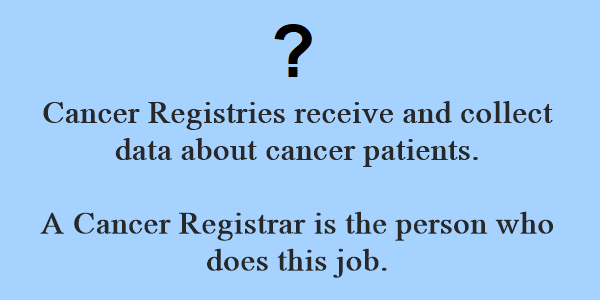Part 2 of a multi-part series on cancer surveillance and data collection in the United States.

Cancer data is collected in the USA by a system of registries. Data collected depends on the purpose of each registry and there are two primary types:
- Hospital Registries, usually a department in a hospital, cancer center or medical facility.
- Population-based Registries, typically found in state health department or government agency.
Hospital Registries provide hundreds of data elements, some of which are quite complex, that is used to study and evaluate the patient care process given within the hospital. Hospital-based data is focused on things like the care of the cancer patient (from diagnosis, treatment and on to lifetime follow-up) to educating the healthcare providers. If a hospital is part of a system or affiliated group of hospitals they may pool their data and use the collective information to learn more about how the different types of cancers respond to the care given system-wide. Pooled data can be used in studies to compare trends or patterns of care, demographic or population subsets or by geographic region.

Population-Based Registries are often a part of a state, or even national, health department system. They collect the information on all cases diagnosed within a certain geographic area. They also pull together information from the reporting facilities within their geographic region that may include, but is not limited to:
- Hospitals,
- Doctor’s offices,
- Nursing homes,
- Pathology laboratories,
- Radiation and chemotherapy (infusion) treatment centers,
- Ambulatory care facilities or clinics,
- Or other cancer care facilities.
Population registries use this larger pool of data to study new cancer cases (or incidence) and death rates (or mortality) in the regions across the United States. Population-based registries can look at cancer rates in certain types of jobs or groups of people, and see if the cancer survival is improving or not in each group. They can also watch trends over time to find out if the rate of a certain type of cancer is increasing or declining over time. Lastly, they can monitor the incidence or mortality rates in age or ethnic groups to see who is most affected by different types of cancer. One example of this type of analysis is published in the Cancer Facts & Figures each year by the American Cancer Society.
Information also reported by hospital-based and population-based registries helps to guide local, regional and national cancer prevention and control programs that focus on changing certain behaviors (like smoking), lifestyle (like healthy eating habits) or environment risks (like asbestos exposure). The data from a cancer registry helps to identify a specific need for increased cancer screening (like lung cancer screening) in a certain region or area.




